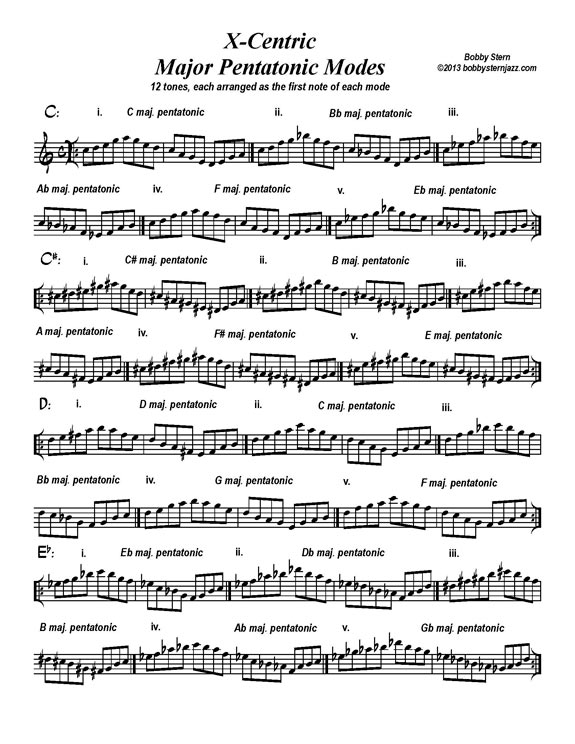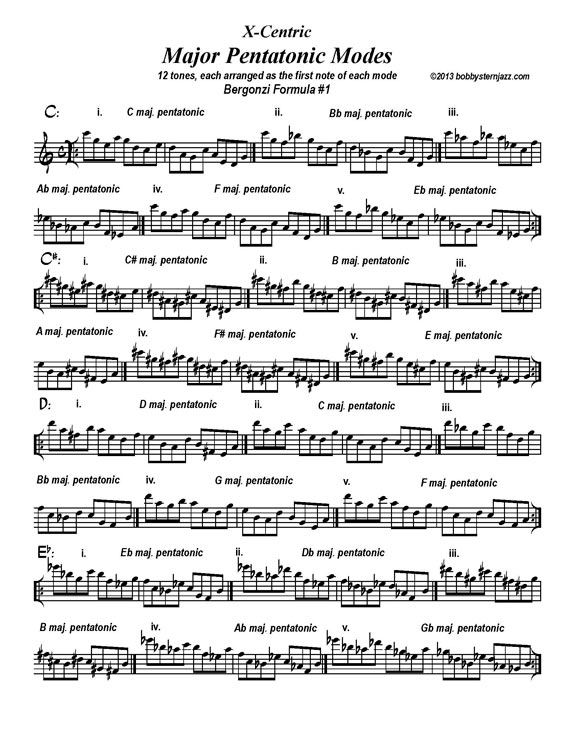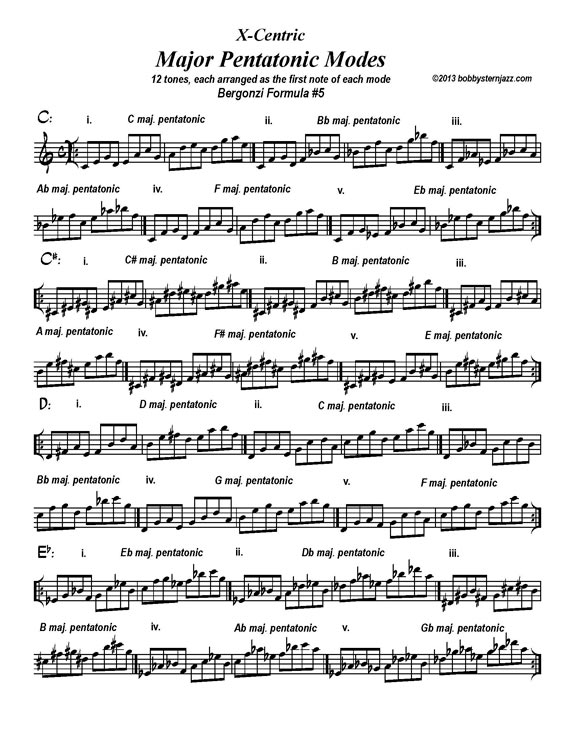A Set of Pentatonic Scale Exercises to Super-Charge Your Technique, Ear, and Improvisation
This article was written by guest contributor, Bobby Stern, a long time professional saxophonist, jazz player, educator, Bari Woodwinds endorser and author of “The Melodic Minor Handbook: A Jazz Player’s Perspective” as well as a new self published eBook “Slick Licks That Stick!”
This is a very useful series of exercises for building your chops and acclimating your ear to different tonal colors. The term “X-Centric”, in this case, doesn’t mean weird or nutty, but defines a concept where X is the variable “central note” around which these exercises (or any series of melodic statements) can be formed.
I believe I first saw this concept related to pentatonics in Ramon Ricker’s book Pentatonic Scales for Jazz Improvisation which I got when it first came out in the mid to late 1970’s. In this book was a chart depicting the 5 pentatonic scale modes started from each of the 12 notes of the chromatic scale, written in whole notes in ascending fashion.
Several years ago (as I realized, that after all those years, I could finally play 5 different pentatonic scale modes from any note without breaking too much of a sweat), I came up with this X-Centric pentatonic exercise. For example, it breaks down like this:
The note C would be the:
- first tone of the “i mode” of C maj. pentatonic (C-D-E-G-A)
- first tone of the “ii mode” of Bb maj. pentatonic (C-D-F-G-Bb)
- first tone of the “iii mode” of Ab maj. pentatonic (C-Eb-F-Ab-Bb)
- first tone of the “iv mode” of F maj. pentatonic (C-D-F-G-A)
- first tone of the “v mode” of Eb maj. pentatonic (C-Eb-F-G-Bb)
This generates 5 different pentatonic modes from the same starting note, each from a different key center.
Now if we take it through the 12 notes of the chromatic scale (12×5), we’ve got 60 distinct pentatonic modes.

When we get this stepwise pentatonic exercise comfortably under our fingers, we can then start checking out some intervalic possibilities. Taking a page from another excellent book, this time Jerry Bergonzi’s popular Vol. 2, Pentatonics, we can apply any of Gonz’s 8 formulas or “shapes” X-Centrically.
(A “step” in this case refers to the distance between adjacent notes of the pentatonic scale, not the diatonic major.)
(X) skip step down (X) step down (X) skip step up (X) step down.
Applying this formula to the i mode of the C Major Pentatonic scale (C – D – E – G – A), this translates, in to:
(C) skip step down to (G), step down to (E) skip step up to (A) step down to (G)
…and the pattern keeps repeating.

In measure 3, we use the same formula starting on C, only this time “C” is the first note of the ii mode of Bb Major Pentatonic.
(C) skip step down to (G), step down to (F) skip step up to (Bb) step down to (G), repeat formula………..
When we flip Bergonzi’s formula #1 upside down, we get formula #5. Now the direction is reversed.
(X) skip step up (X) step up (X) skip step down (X) step up, repeat…..
i mode of C: (C) skip step up to (E) step up to (G) skip step down to (D) step up to (E), etc.
ii mode of Bb: (C) skip step up to (F) step up to (G) skip step down to (D) step up to (F), etc.

Hey, I think you’ve got it! You can try it with any of the eight Bergonzi shapes or any of your own 5 note patterns. It gets really interesting when you start to use these schemes with pentatonics flat 3, flat 6, flat 2, etc.
For that matter, the X-Centric approach should work, theoretically, with any non-symmetrical scale of any length.
Experiment! Have Fun!!
Click the links below to download the exercises in much more readable PDF format:
Delve Deeper with Bobby
If you liked this exercise and found it useful, Bobby’s new eBook Slick Licks That Stick! contains 177 pages of chops building, non-cliche exercises, licks and patterns, which can be most useful for the improvising musician of any level or stage of development.






March 14, 2013 @ 9:41 am
Thank you, Bobby! Good exercises! I’ll practice)
March 24, 2013 @ 2:32 pm
I enjoyed reading the article and now I have some new exercises to run through!
Man, no matter how much you practice there are always new concepts and things to learn on the sax. I love it!
Thanks and Play On!
//Greger
January 10, 2014 @ 2:00 pm
utilissimi esercizi per il mio livello e divertenti da eseguire.
Maury
May 26, 2015 @ 4:36 am
I was guessing if You Could write a little more on this subject? I’d be very grateful if You Could elaborate a little bit more.
July 30, 2015 @ 5:58 am
Thank you very much for your kind sharing.
May 8, 2016 @ 11:28 am
Thank you for generously sharing this information. A great resource which both my students and myself appreciate.
February 22, 2017 @ 11:48 am
Thank you for your sharing
January 22, 2019 @ 1:20 am
Thank you for sharing. Your info is helpful and re-endorcing.
October 17, 2019 @ 8:58 am
muito obrigado !!! vou estudar essas escalas
April 3, 2020 @ 4:57 am
Many Thanks !!!
July 25, 2020 @ 8:19 am
good
July 25, 2020 @ 8:23 am
i’m interesting in this pentatonic scale
July 28, 2020 @ 6:02 am
Please send me the scales. Thanks!
March 7, 2021 @ 8:36 pm
Really helpful.
March 9, 2021 @ 5:39 pm
I loved these exercises.
May 17, 2021 @ 10:12 pm
WARNING: Don’t do these exercises unless you wan’t to sound like a robot.
June 5, 2021 @ 10:30 am
ADVISORY: The only way you will sound like a robot from doing these exercises is if YOU already ARE ONE!!
August 23, 2022 @ 10:48 am
It is so good and nice